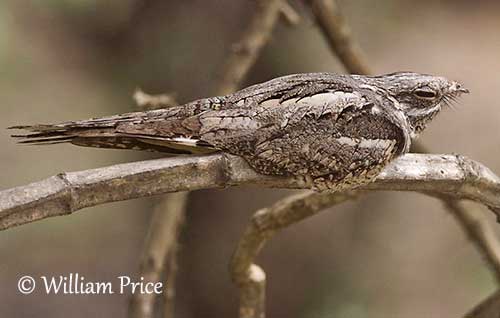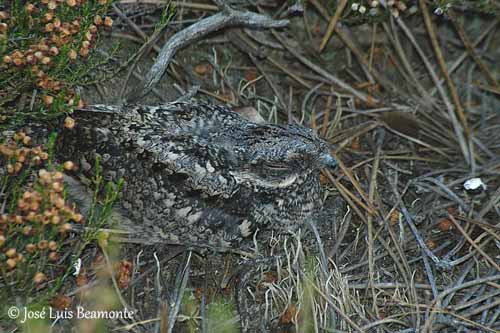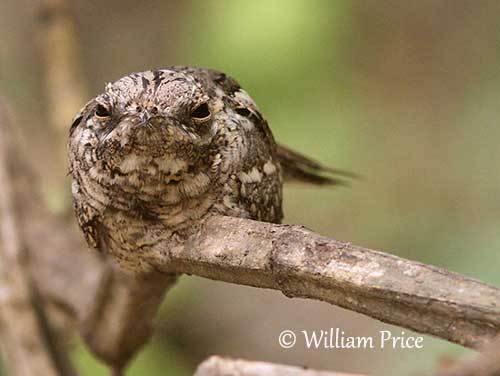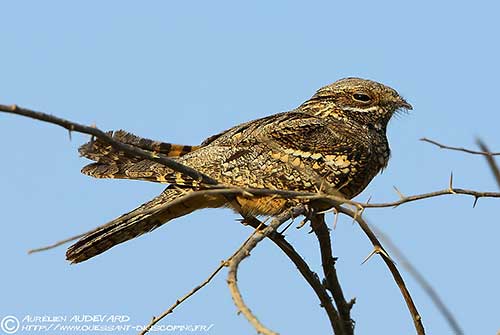
Fr: Engoulevent d’Europe
All : Ziegenmelker
Esp : Chotacabras Europeo
Ital : Succiacapre europeo
Nd : Nachtzwaluw
Sd : Nattskärra
Port : Noitibó da Europa
Photographers:
Aurélien Audevard
OUESSANT DIGISCOPING
José Luis Beamonte
Pájaros de España
William Price
PBase-tereksandpiper & Flickr William Price
Text by Nicole Bouglouan
Sources:
HANDBOOK OF THE BIRDS OF THE WORLD Vol 5 by Josep del Hoyo-Andrew Elliott-Jordi Sargatal - Lynx Edicions - ISBN: 8487334253
THE HANDBOOK OF BIRD IDENTIFICATION FOR EUROPE AND THE WESTERN PALEARCTIC by Mark Beaman, Steve Madge - C.Helm - ISBN: 0713639601
THE COMPLETE BOOK OF BRITISH BIRDS – Written by “Royal Society for the Protection of Birds” experts - Préface de Magnus Magnusson - Michael Cady- Rob Hume Editors - ISBN: 0749509112
L’ENCYCLOPEDIE MONDIALE DES OISEAUX - Dr Christopher M. Perrins - BORDAS - ISBN: 2040185607
ENCYCLOPEDIE DES OISEAUX DE FRANCE ET D’EUROPE – de Peter Hayman et Rob Hume - Flammarion – ISBN : 2082009920
The IUCN Red List of Threatened Species
Wikipedia (Wikipedia, The Free Encyclopedia)
European Nightjar
Caprimulgus europaeus
Caprimulgiforme Order – Caprimulgidae Family
BIOMETRICS :
Length: 25-28 cm
Weight: M: 50-100 g – F: 67-95 g
DESCRIPTION:
A secret bird often difficult to see, the European Nightjar can be invisible during the day, thanks to its cryptic plumage. Active at dawn and dusk, this beautiful bird is a dream for the photographers!
Adult male has greyish-brown upperparts with blackish-brown streaks, and indistinct pale bull collar on the lower nape.
On the upperwing, lesser coverts are brown and others are greyish-brown with pale buff spots, forming a line across the forewing, and a second line along the scapulars.
Underparts are greyish-brown too, with brown bars and buff spots. Belly and flanks are buff with brown bars.
The male shows a white spot on the 3-4 outer primary flight feathers, and the two outermost rectrices have white tips, mainly visible in flight.
Head is like upperparts but we can see broad creamy-white malar stripe and white throat patch.
The bill is blackish with large gape, surrounded by nasal bristles used for hunting. Eyes are dark brown. The short legs and feet are brown to pinkish-brown.

Female has similar plumage but she lacks the white markings, and the wing patches are mostly yellowish-brown.
Juvenile resembles female and also lacks the white markings.
We can find six subspecies: C.e. europaeus, meridionalis, sarudnyi, unwini, plumipes and dementievi.
The races slightly differ in colour and size, becoming smaller and paler to East through range, and with larger white wing spots in males.
All the races winter in sub-Saharan Africa.
VOICE: SOUNDS BY XENO-CANTO
The European Nightjar’s contact calls are often given in flight. It is a nasal frog-like “quaw-eek” or “kooik”.
Both sexes utter a wide variety of short calls such as “chunk”, “dak”, “chek”… and also clucking notes.
At nest, both adults grunt or give “wuk, wuk, wuk” or muffled “oak, oak”. The female gives loud quacks.
During the defence displays, both sexes produce guttural hisses.
The advertising call by male is a far-carrying hollow churring which may last several minutes with frequent changes of pitch. This call is given at dusk from a perch.
HABITAT:
The European Nightjar frequents dry, open country, heathland with some trees, forest, clearing and edges, wooded or scrub-covered steppes, hillsides, oak scrubland, sandy dunes, semi-desert with scattered trees or bushes, and desert.
This species forages in farmland, gardens, reedbeds, wet habitat and marshes.
The wintering areas include wooded country, forest clearing, dry coastal acacia steppes and open sandy areas.
The European Nightjar can be seen from sea-level up to 2800 metres of elevation on the breeding grounds, and up to 5000 metres during winter.
RANGE:
The European Nightjar breeds throughout Northern and Central Europe, from S Scandinavia, W Europe and N Africa, to NW China and NE Mongolia.
It winters in sub-Saharan Africa and as far as The Cape.
BEHAVIOUR:
The European Nightjar feeds primarily on wide variety of insects and occasionally butterflies and spiders.
It forages while flying in agile and buoyant fashion, over open countries or in clearings, along forest edges, in gardens, orchards, over wetlands, meadows and cultivated areas, pastures and ponds.
The European Nightjar hunts solitary but we can see sometimes loose groups. It can take insects at artificial light, but it also hunts by day when the sky is cloudy and dark.
It also performs short flycatching sallies from its low perch or from the ground, and hovers to catch insects from the vegetation. It rarely swoops down onto the prey or feeds on the ground.
It drinks while flying, taking the water with open bill from the lake surface.
The European Nightjar often rests during the day, motionless and invisible, sitting along a branch, thanks to the cryptic plumage similar to the bark. It can be seen also on the ground among the dead leaves. If the bird is disturbed, it remains motionless, with sleeked plumage and almost closed eyelids, leaving only narrow slits.
The European Nightjar performs display flights, clapping loudly its wings. It also glides with raised wings and spread tail. This flight is butterfly-like. During these aerial courtships, the male displays the white wing markings by gliding with wings held in V-shape and fanned tail.
These displays occur at dusk and are accompanied by the monotonous, persistent churring.
The male establishes the territory by singing from invisible boundaries, and defends it strongly against rivals. The male sings strongly towards the singing neighbour. Both may adopt aggressive posture with dropped wings and fanned or raised tail.
Physical contact can occur in more extreme disputes. Two males fly at each other while hitting out with the wings and bill-grappling. Usually, these fights end when both birds fall to the ground before to break off, and then, each one goes its own way.
The European Nightjar is highly migratory and usually migrates at night.
FLIGHT:
The European Nightjar is a good flier, thanks to the long slender wings. The flight is agile and buoyant. When foraging, it performs flycatching and hovering. The flight displays are butterfly-like.
REPRODUCTION:
Breeding season usually occurs from late May to August, and is often influenced by lunar phase.
The European Nightjar is generally monogamous and produces one or two clutches per season.
This species nests on the ground. There is not nest. Eggs are laid on the leaf litter, on pine needles or on the bare ground, in open area but beneath a tree, scrub or bush, among vegetation or tree roots. The nest-site may be reused for some successive years.
The female lays 1-2 whitish, grey-white or cream eggs with brown, grey and yellowish spots and blotches. They are laid at 36-48 hours intervals.
Incubation lasts about 17-21 days, mainly by female, and starts with the first egg laid.
Chicks are semi-precocial. They have brown and creamy-buff down. Female broods them during 10-15 days, but if a second clutch is laid, the male broods the chicks while the female incubates.
The young fledge 16-17 days after hatching, and are independent at one month.
If the female is threatened at nest, she performs injury-feigning distraction from perch, on the ground or while flying.
DIET:
The European Nightjar feeds mainly on insects such as beetles, mantises, mayflies, dragonflies, cockroaches, bugs, orthoptera, hymenoptera and several others.
It also may take occasionally butterflies and glow-worms, and spiders too.
Its large gape allows it to catch prey in flight, and by flycatching sallies and hovering close to the vegetation.
PROTECTION / THREATS / STATUS:
The European Nightjar is locally common in suitable habitat throughout the breeding range, but decreases are observed in NW Europe.
This species has numerous predators for eggs and chicks, due to the nesting habits on the ground. There are Corvidae, Strigidae and Birds of prey, but also mammals such as hedgehogs, weasels and dogs.
However, the species is considered as LEAST CONCERN.


